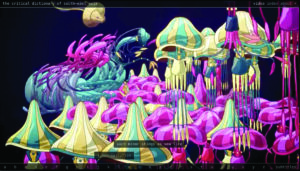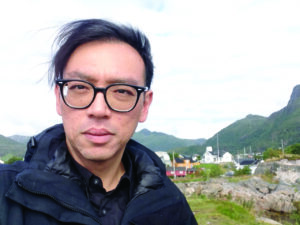By Becky Mayad
The Crow Museum of Asian Art of The University of Texas at Dallas will present the United States. premiere of The Critical Dictionary of Southeast Asia by internationally renowned artist Ho Tzu Nyen, featuring an enthralling, constantly evolving moving-image installation. The exhibition opens Sept. 25, and continues through Jan. 30, 2022 at the museum’s location in the Dallas Arts District, 2010 Flora St.

Photos courtesy of the Crow Museum of Asian Art of The University of Texas at Dallas
The Critical Dictionary of Southeast Asia is part of an ongoing project that grows, generates and provides critical insight into the pluralistic definitions of the territories under the term “Southeast Asia.” Born out of recognition for how sweeping the term “Southeast Asia” is, the project considers what makes up an area not unified by language, religion or political power.
“This is the moment to premiere this work in the United States. At a time in which interpretations can be unclear and when understandings are often misrepresented, we are being called to a new consciousness for how culture has needlessly assigned meaning,” said Amy Lewis Hofland, senior director of the Crow Museum of Asian Art. “The beauty of Ho’s work is his thoughtfulness to take this on; deconstructing a term like Southeast Asia is an invitation to see the individual rather than the habitual action of grouping individuals, cultures and meanings.”
Hofland believes the exhibition will be warmly embraced. She is hoping is that Ho’s exploration provokes conversation and inspires greater understanding and awareness. She notes that Ho, who is a Singapore native, was named by the prestigious publication ArtReview magazine to its “Power 100” list of the “most influential people in 2019 in the contemporary art world.”

At the heart of the exhibition is an always-changing video and LED light installation in which an algorithm — created by the artist in collaboration with software developer Jan Gerber and media artist Sebastian Lütgert — weaves together a rich tapestry of texts, music and found footage pertaining to an alphabetized list of concepts, generating different permutations with every loop.
This stream of algorithmically edited images is accompanied by the voiceover of Singaporean musician and vocalist Bani Haykal, who sings a series of notes about Southeast Asia that Ho has accumulated throughout many years of research.
Narrated in English, these notes offer sometimes condensed and sometimes rewritten explanations of a number of keywords that Ho sees are of particular significance in the Southeast Asian context, such as anarchism, buffalo, corruption, decay, epidemics, forest, ghosts, humidity, weretiger, etc.
“By looking at the history of the region as collected through a series of ambiguous historical, literary and pop culture references, Ho Tzu Nyen’s The Critical Dictionary of Southeast Asia presents an endless view of possible ‘Southeast Asias’ to consider,” said Jacqueline Chao, Ph.D., curator of the exhibition and senior curator of Asian Art for the Crow Museum of Asian Art. “This constantly shifting, multisensory installation experience questions the power of shared belief and interrogates the nature of ‘facts’ and what we think we know, while simultaneously opening the door to new readings, interpretations and discovery.”
The installation will be complemented with additional texts related to the work, including an index of dictionary terms, as well as selections from Ho’s research notes. Seating will be available in the gallery, allowing visitors to fully experience the truly unique presentation.
“Southeast Asia is a region of dazzling heterogeneity, characterized by an unruly plurality of languages, ethnicities and belief systems, and this project can, in some sense, be regarded as an attempt to find, or to create, a form for this region which is not one,” said Ho. “I am especially pleased to be able to present this work in the context of the Crow Museum of Asian Art, where the present and the past, the contemporary and the historical, intersect in so many ways.”
A celebrated artist with a broad following across Asia and the globe, Ho Tzu Nyen is known for creating films, installations and performances that begin as engagements with historical and theoretical texts. His recent works are populated by metamorphic figures such as the weretiger (One or Several Tigers, 2017) and the triple agent (The Nameless, 2015), under the rubric of The Critical Dictionary of Southeast Asia.
His works have been presented at the Yamaguchi Center for Arts and Media (2021), Edith-Russ-Haus for Media Art in Oldenburg (2019), Kunstverein in Hamburg (2018), Ming Contemporary Art Museum (Shanghai, 2018), Asia Art Archive in Hong Kong (2017), Guggenheim Bilbao (2015) and Mori Art Museum in Tokyo (2012). He represented the Singapore Pavilion at the 54th Venice Biennale (2011).
Recent group exhibitions include the 12th Gwangju Biennale (2021), Aichi Triennale (2019) and 2 or 3 Tigers at the Haus der Kulturen der Welt, Berlin (2017).
Together with Taiwanese artist Hsu Chia-Wei, he co-curated “The Strangers from Beyond the Mountain and the Sea,” the 7th Asian Art Biennial (2019) at the National Taiwan Museum of Fine Arts.
NOTE: The installation is a moving image work with sensitive imagery, low light, occasional bursts of bright or flashing light and loud noise. Viewer discretion is advised.
Face coverings are strongly encouraged. Hand sanitizer is available throughout the museum, and staff practice heightened cleaning procedures throughout the day.
The Crow Museum of Asian Art of The University of Texas at Dallas is open Tuesdays-Sundays 11 a.m.-5 p.m. and is closed on Mondays. The museum is located in downtown Dallas at 2010 Flora St., 75201. Admission is free; $12 suggested donation for adults. For more information, go to crowmuseum.org or call 214-979-6430.
